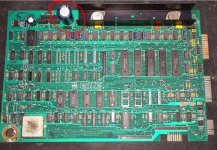robert_sissco
Experienced Member
So, I have a PET 4032 that is having a few issues that I need help with. I do not have an oscilloscope YET (it is literally in the mail) but one issue I want to tackle first is the power issue. When I cold boot the system, I get nothing. The school district the guy I bought it from got it from has an LED wired into the transformer, and that always goes no, but I will not get anything on screen and no chirp. I let this sit for a few second then power cycle and it boots up "fine" (other issue to come later, I think I need to scope for this). Now I keep rebooting, always comes up. Let is set for a few minutes, I need to to the cold boot cycle again.
This makes me think it might be the big blue capacitor, BUT I have a Tynemuth TinyPET board, the old through hold board designed to go into a PET case, which means I can hook it up to the same power supply I think is suspect and...it books every time. I do not need to do the cold boot warm up then power cycle it for it to boot up no matter how long I let it sit.
I also did check and there is no sign that the big clue blue is leaking, so I am not sure where to check next.
Any ideas?
This makes me think it might be the big blue capacitor, BUT I have a Tynemuth TinyPET board, the old through hold board designed to go into a PET case, which means I can hook it up to the same power supply I think is suspect and...it books every time. I do not need to do the cold boot warm up then power cycle it for it to boot up no matter how long I let it sit.
I also did check and there is no sign that the big clue blue is leaking, so I am not sure where to check next.
Any ideas?


